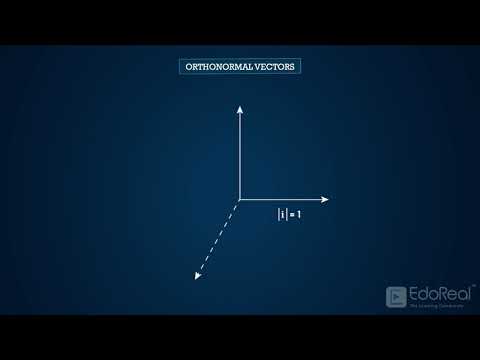Introduction
Orthonormal vectors are a set of vectors that are both orthogonal (perpendicular) to each other and have a unit length (norm) of 1. In other words, the dot product of any two distinct vectors in the set is zero, and the dot product of a vector with itself is 1. Orthonormal vectors play a crucial role in machine learning, particularly in the context of dimensionality reduction and feature extraction. Techniques such as Principal Component Analysis (PCA) rely on finding orthonormal bases that can optimally represent the variance in the data, enabling efficient compression and noise reduction.
Additionally, orthonormal vectors are used in various machine learning algorithms to simplify computations, improve numerical stability, and facilitate the interpretation of results. Their orthogonal nature ensures that the dimensions in the transformed space are independent and uncorrelated, which is often a desirable property in machine learning models.
Linear algebra, which deals with vectors and matrices, is one of the fundamental branches of mathematics for machine learning. Vectors are often used to represent data points or features, while matrices are used to represent collections of data points or sets of features. In image recognition tasks, an image can be represented as a vector of pixel values, and a set of images can be represented as a matrix where each row corresponds to an image vector.
By using vectors to represent data, machine learning or deep learning algorithms can apply mathematical operations such as matrix multiplication and dot products to manipulate and analyze the data. For example, vector operations such as cosine similarity can be used to measure the similarity between two data points or to project high-dimensional data onto a lower-dimensional space for visualization or analysis. By grouping similar vectors together or predicting the value of a target variable based on the values of other variables, these algorithms can make predictions or identify patterns in the data.
There are different types of vectors such as orthogonal vector, orthonormal vector, column vector, row vector, dimensional feature vector, independent vector, resultant feature vector, etc.
The difference between a column vector and a row vector is primarily a matter of convention and notation. In most cases, the choice of whether to use a column vector or a row vector depends on the context and the specific application.
Dimensional feature vector is a representation of an object or entity that captures relevant information about its properties and characteristics in a multidimensional space. In other words, it is a set of features or attributes that describe an object, and each feature is assigned a value in a numerical vector.
A vector is considered an independent vector if no vector can be expressed as a linear combination of those listed before it in the set. independent vector independent vector.
Resultant feature vector is a vector that summarizes or combines multiple feature vectors into a single vector that captures the most important information from the original vectors. The process of combining feature vectors is called feature aggregation, and it is often used in machine learning and data analysis applications where multiple sources of information need to be combined to make a decision or prediction. Resultant feature vectors can be useful in reducing the dimensionality of data and in summarizing complex information into a more manageable form. They are widely used in applications such as image and speech recognition, natural language processing, and recommendation systems.
Also Read: What is a Sparse Matrix? How is it Used in Machine Learning?
Orthogonal and Orthonormal Vectors
In the context of data analysis and modeling, it can be useful to transform the original variables or input variables into a new set of variables that are orthogonal or orthonormal. Explanatory variables can be thought of as the components of the vector that are used to explain or predict a response variable and its components can be thought of as quantitative variables.
Orthogonal and orthonormal vector algorithms play an important in machine learning because they enable efficient computations, simplify many mathematical operations, and can improve the performance of many machine learning algorithms.




